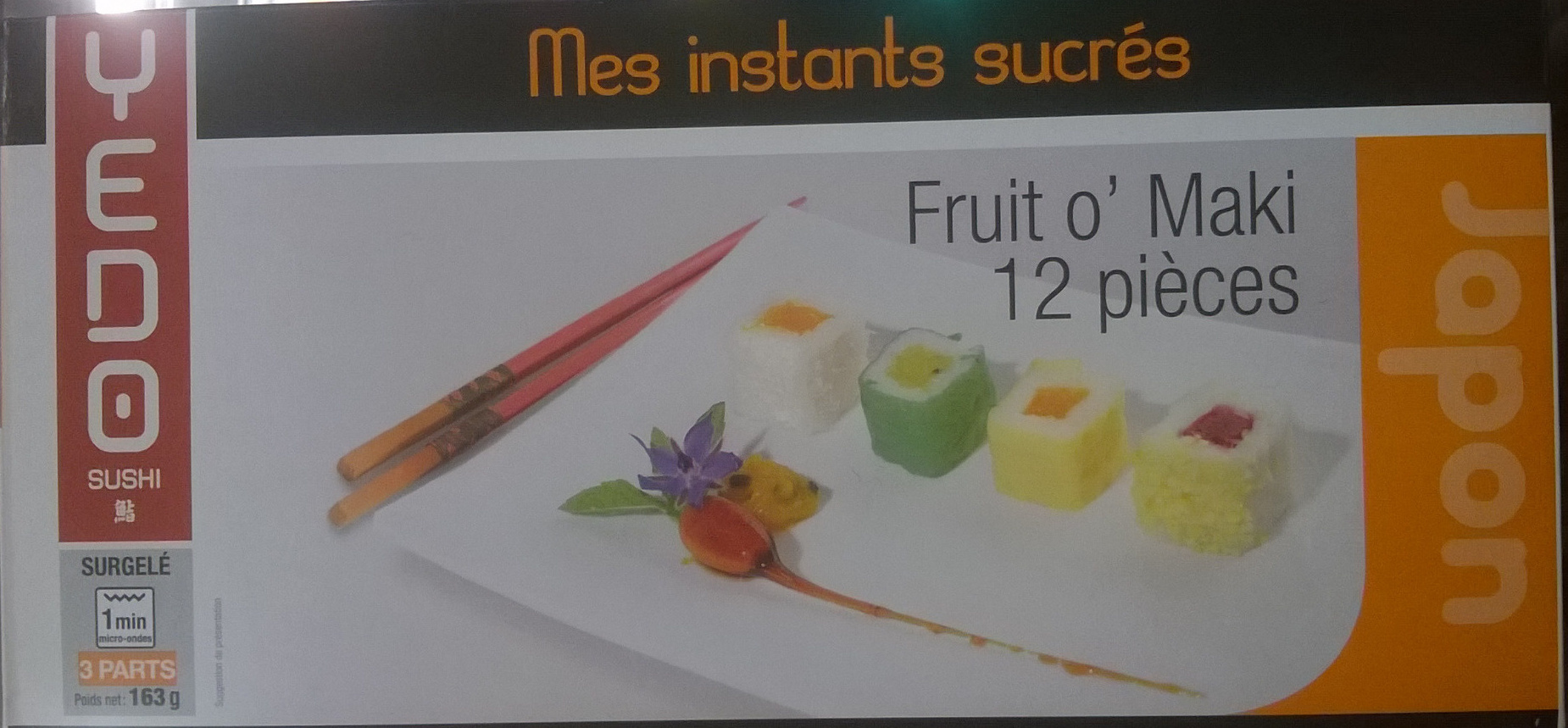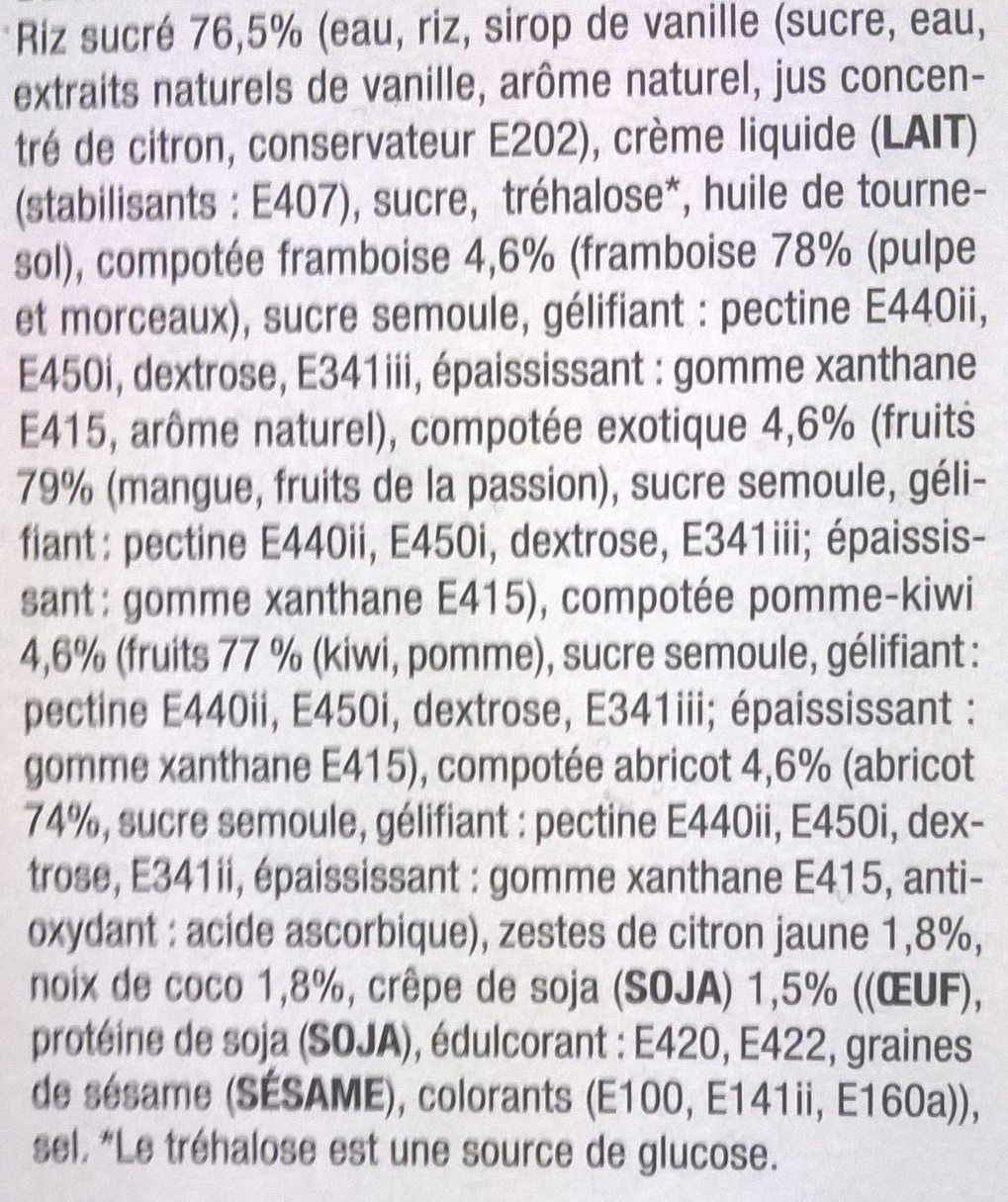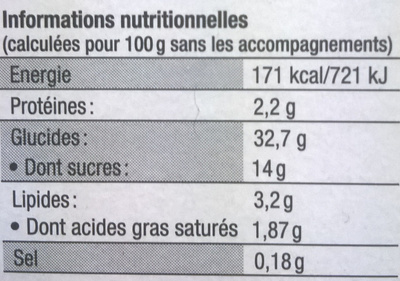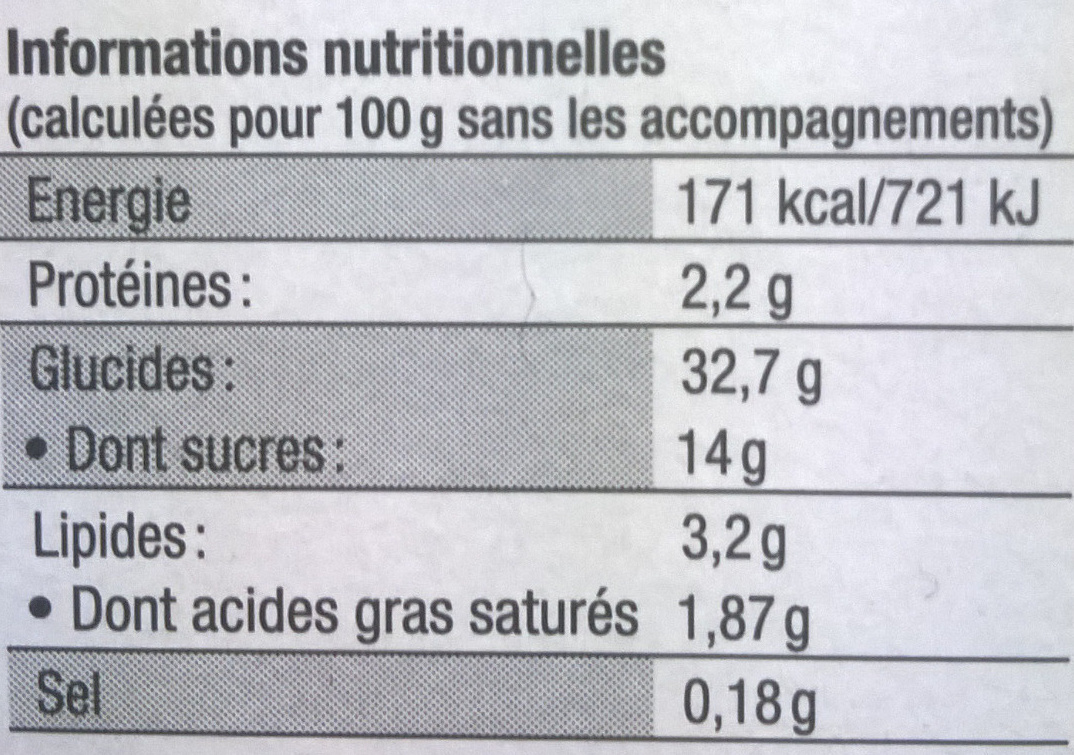Help us make food transparency the norm!
As a non-profit organization, we depend on your donations to continue informing consumers around the world about what they eat.
The food revolution starts with you!
Fruit o' Maki - Yedo Sushi - 163 g
Fruit o' Maki - Yedo Sushi - 163 g
This product page is not complete. You can help to complete it by editing it and adding more data from the photos we have, or by taking more photos using the app for Android or iPhone/iPad. Thank you!
×
Barcode: 3760022339751 (EAN / EAN-13)
Common name: Bouchées à bas de riz sucré et de compotées de fruits
Quantity: 163 g
Packaging: Box, Cardboard, Frozen
Brands: Yedo Sushi
Categories: Desserts, Frozen foods, Meals, Sushi and Maki, Makis
Countries where sold: France
Matching with your preferences
Health
Ingredients
-
79 ingredients
: Riz sucré 76,5% (eau, riz, sirop de vanille (sucre, eau, extraits naturels de vanille, arôme naturel, jus concentré de citron, conservateur E202), crème liquide (LAIT) (stabilisants : E407), sucre, tréhalose*, huile de tournesol), compotée framboise 4,6% (framboise 78% (pulpe et morceaux), sucre semoule, gélifiant : pectine E440ii, E450i, dextrose, E341iii, épaississant : gomme xanthane E415, arôme naturel), compotée exotique 4,6% (fruits 79% (mangue, fruits de la passion), sucre semoule, gélifiant: pectine E440ii, E450i, dextrose, E341iii; épaississant : gomme xanthane E415),compotée pomme-kiwi 4,6% (fruits 77 % (kiwi, pomme), sucre semoule, gélifiant : pectine E440ii, E450i, dextrose, E341iii, épaississant : gomme xanthane E415), compotée abricot 4,6% (abricot 74%, sucre semoule, gélifiant : pectine E440ii, E450i, dextrose, E341ii, épaississant : gomme xanthane E415, antioxydant : acide ascorbique), zestes de citron jaune 1,8%, noix de coco 1,8%, crêpe de soja (SOJA) 1,5% ((OEUF), protéine de soja (SOJA), édulcorant : E420, E422, graines de sésame (SÉSAME), colorants (E100, E141ii, E160a)), sel. * Le tréhalose est une source de glucose.Allergens: Eggs, Kiwi, Milk, Sesame seeds, Soybeans
Food processing
-
Ultra processed foods
Elements that indicate the product is in the 4 - Ultra processed food and drink products group:
- Additive: E100 - Curcumin
- Additive: E141 - Copper complexes of chlorophylls and chlorophyllins
- Additive: E160a - Carotene
- Additive: E407 - Carrageenan
- Additive: E415 - Xanthan gum
- Additive: E420 - Sorbitol
- Additive: E422 - Glycerol
- Additive: E440 - Pectins
- Additive: E450 - Diphosphates
- Ingredient: Colour
- Ingredient: Dextrose
- Ingredient: Flavouring
- Ingredient: Gelling agent
- Ingredient: Glucose
- Ingredient: Sweetener
- Ingredient: Thickener
Food products are classified into 4 groups according to their degree of processing:
- Unprocessed or minimally processed foods
- Processed culinary ingredients
- Processed foods
- Ultra processed foods
The determination of the group is based on the category of the product and on the ingredients it contains.
Additives
-
E160a - Carotene
Carotene: The term carotene -also carotin, from the Latin carota, "carrot"- is used for many related unsaturated hydrocarbon substances having the formula C40Hx, which are synthesized by plants but in general cannot be made by animals -with the exception of some aphids and spider mites which acquired the synthesizing genes from fungi-. Carotenes are photosynthetic pigments important for photosynthesis. Carotenes contain no oxygen atoms. They absorb ultraviolet, violet, and blue light and scatter orange or red light, and -in low concentrations- yellow light. Carotenes are responsible for the orange colour of the carrot, for which this class of chemicals is named, and for the colours of many other fruits, vegetables and fungi -for example, sweet potatoes, chanterelle and orange cantaloupe melon-. Carotenes are also responsible for the orange -but not all of the yellow- colours in dry foliage. They also -in lower concentrations- impart the yellow coloration to milk-fat and butter. Omnivorous animal species which are relatively poor converters of coloured dietary carotenoids to colourless retinoids have yellowed-coloured body fat, as a result of the carotenoid retention from the vegetable portion of their diet. The typical yellow-coloured fat of humans and chickens is a result of fat storage of carotenes from their diets. Carotenes contribute to photosynthesis by transmitting the light energy they absorb to chlorophyll. They also protect plant tissues by helping to absorb the energy from singlet oxygen, an excited form of the oxygen molecule O2 which is formed during photosynthesis. β-Carotene is composed of two retinyl groups, and is broken down in the mucosa of the human small intestine by β-carotene 15‚15'-monooxygenase to retinal, a form of vitamin A. β-Carotene can be stored in the liver and body fat and converted to retinal as needed, thus making it a form of vitamin A for humans and some other mammals. The carotenes α-carotene and γ-carotene, due to their single retinyl group -β-ionone ring-, also have some vitamin A activity -though less than β-carotene-, as does the xanthophyll carotenoid β-cryptoxanthin. All other carotenoids, including lycopene, have no beta-ring and thus no vitamin A activity -although they may have antioxidant activity and thus biological activity in other ways-. Animal species differ greatly in their ability to convert retinyl -beta-ionone- containing carotenoids to retinals. Carnivores in general are poor converters of dietary ionone-containing carotenoids. Pure carnivores such as ferrets lack β-carotene 15‚15'-monooxygenase and cannot convert any carotenoids to retinals at all -resulting in carotenes not being a form of vitamin A for this species-; while cats can convert a trace of β-carotene to retinol, although the amount is totally insufficient for meeting their daily retinol needs.Source: Wikipedia
-
E202 - Potassium sorbate
Potassium sorbate (E202) is a synthetic food preservative commonly used to extend the shelf life of various food products.
It works by inhibiting the growth of molds, yeast, and some bacteria, preventing spoilage. When added to foods, it helps maintain their freshness and quality.
Some studies have shown that when combined with nitrites, potassium sorbate have genotoxic activity in vitro. However, potassium sorbate is generally recognized as safe (GRAS) by regulatory authorities.
-
E341 - Calcium phosphates
Calcium phosphate: Calcium phosphate is a family of materials and minerals containing calcium ions -Ca2+- together with inorganic phosphate anions. Some so-called calcium phosphates contain oxide and hydroxide as well. They are white solids of nutritious value.Source: Wikipedia
-
E341ii - Dicalcium phosphate
Calcium phosphate: Calcium phosphate is a family of materials and minerals containing calcium ions -Ca2+- together with inorganic phosphate anions. Some so-called calcium phosphates contain oxide and hydroxide as well. They are white solids of nutritious value.Source: Wikipedia
-
E341iii - Tricalcium phosphate
Calcium phosphate: Calcium phosphate is a family of materials and minerals containing calcium ions -Ca2+- together with inorganic phosphate anions. Some so-called calcium phosphates contain oxide and hydroxide as well. They are white solids of nutritious value.Source: Wikipedia
-
E407 - Carrageenan
Carrageenan (E407), derived from red seaweed, is widely employed in the food industry as a gelling, thickening, and stabilizing agent, notably in dairy and meat products.
It can exist in various forms, each imparting distinct textural properties to food.
However, its degraded form, often referred to as poligeenan, has raised health concerns due to its potential inflammatory effects and its classification as a possible human carcinogen (Group 2B) by the International Agency for Research on Cancer (IARC).
Nevertheless, food-grade carrageenan has been deemed safe by various regulatory bodies when consumed in amounts typically found in food.
-
E415 - Xanthan gum
Xanthan gum (E415) is a natural polysaccharide derived from fermented sugars, often used in the food industry as a thickening and stabilizing agent.
This versatile food additive enhances texture and prevents ingredient separation in a wide range of products, including salad dressings, sauces, and gluten-free baked goods.
It is considered safe for consumption even at high intake amounts.
-
E420 - Sorbitol
Sorbitol: Sorbitol --, less commonly known as glucitol --, is a sugar alcohol with a sweet taste which the human body metabolizes slowly. It can be obtained by reduction of glucose, which changes the aldehyde group to a hydroxyl group. Most sorbitol is made from corn syrup, but it is also found in nature, for example in apples, pears, peaches, and prunes. It is converted to fructose by sorbitol-6-phosphate 2-dehydrogenase. Sorbitol is an isomer of mannitol, another sugar alcohol; the two differ only in the orientation of the hydroxyl group on carbon 2. While similar, the two sugar alcohols have very different sources in nature, melting points, and uses.Source: Wikipedia
-
E422 - Glycerol
Glycerol: Glycerol -; also called glycerine or glycerin; see spelling differences- is a simple polyol compound. It is a colorless, odorless, viscous liquid that is sweet-tasting and non-toxic. The glycerol backbone is found in all lipids known as triglycerides. It is widely used in the food industry as a sweetener and humectant and in pharmaceutical formulations. Glycerol has three hydroxyl groups that are responsible for its solubility in water and its hygroscopic nature.Source: Wikipedia
-
E440 - Pectins
Pectins (E440) are natural carbohydrates, predominantly found in fruits, that act as gelling agents in the food industry, creating the desirable jelly-like texture in jams, jellies, and marmalades.
Pectins stabilize and thicken various food products, such as desserts, confectioneries, and beverages, ensuring a uniform consistency and quality.
Recognized as safe by various health authorities, pectins have been widely used without notable adverse effects when consumed in typical dietary amounts.
-
E440ii - Amidated pectin
Pectin: Pectin -from Ancient Greek: πηκτικός pēktikós, "congealed, curdled"- is a structural heteropolysaccharide contained in the primary cell walls of terrestrial plants. It was first isolated and described in 1825 by Henri Braconnot. It is produced commercially as a white to light brown powder, mainly extracted from citrus fruits, and is used in food as a gelling agent, particularly in jams and jellies. It is also used in dessert fillings, medicines, sweets, as a stabilizer in fruit juices and milk drinks, and as a source of dietary fiber.Source: Wikipedia
-
E450 - Diphosphates
Diphosphates (E450) are food additives often utilized to modify the texture of products, acting as leavening agents in baking and preventing the coagulation of canned food.
These salts can stabilize whipped cream and are also found in powdered products to maintain their flow properties. They are commonly present in baked goods, processed meats, and soft drinks.
Derived from phosphoric acid, they're part of our daily phosphate intake, which often surpasses recommended levels due to the prevalence of phosphates in processed foods and drinks.
Excessive phosphate consumption is linked to health issues, such as impaired kidney function and weakened bone health. Though diphosphates are generally regarded as safe when consumed within established acceptable daily intakes, it's imperative to monitor overall phosphate consumption to maintain optimal health.
Ingredients analysis
-
May contain palm oil
Ingredients that may contain palm oil: E160a
-
Non-vegan
Non-vegan ingredients: Single creamSome ingredients could not be recognized.
We need your help!
You can help us recognize more ingredients and better analyze the list of ingredients for this product and others:
- Edit this product page to correct spelling mistakes in the ingredients list, and/or to remove ingredients in other languages and sentences that are not related to the ingredients.
- Add new entries, synonyms or translations to our multilingual lists of ingredients, ingredient processing methods, and labels.
If you would like to help, join the #ingredients channel on our Slack discussion space and/or learn about ingredients analysis on our wiki. Thank you!
-
Vegetarian status unknown
Unrecognized ingredients: fr:compotee-framboise, Pulp, fr:compotee-exotique, fr:compotee-pomme-kiwi, fr:compotee-abricot, fr:crepe-de-soja, fr:le-trehalose-est-une-source-de-glucoseSome ingredients could not be recognized.
We need your help!
You can help us recognize more ingredients and better analyze the list of ingredients for this product and others:
- Edit this product page to correct spelling mistakes in the ingredients list, and/or to remove ingredients in other languages and sentences that are not related to the ingredients.
- Add new entries, synonyms or translations to our multilingual lists of ingredients, ingredient processing methods, and labels.
If you would like to help, join the #ingredients channel on our Slack discussion space and/or learn about ingredients analysis on our wiki. Thank you!
-
Details of the analysis of the ingredients
We need your help!
Some ingredients could not be recognized.
We need your help!
You can help us recognize more ingredients and better analyze the list of ingredients for this product and others:
- Edit this product page to correct spelling mistakes in the ingredients list, and/or to remove ingredients in other languages and sentences that are not related to the ingredients.
- Add new entries, synonyms or translations to our multilingual lists of ingredients, ingredient processing methods, and labels.
If you would like to help, join the #ingredients channel on our Slack discussion space and/or learn about ingredients analysis on our wiki. Thank you!
: Riz 76.5% (eau, riz, de vanille (sucre, eau, extraits naturels de vanille, arôme naturel, jus concentré de citron, conservateur (e202)), crème liquide (stabilisants (e407)), sucre, tréhalose, huile de tournesol), compotée framboise 4.6% (framboise 78% (pulpe), sucre semoule, gélifiant (pectine e440ii), e450i, dextrose, e341iii, épaississant (gomme xanthane e415), arôme naturel), compotée exotique 4.6% (fruits 79% (mangue, fruits de la passion), sucre semoule, gélifiant (pectine e440ii), e450i, dextrose, e341iii, épaississant (gomme xanthane e415)), compotée pomme-kiwi 4.6% (fruits 77% (kiwi, pomme), sucre semoule, gélifiant (pectine e440ii), e450i, dextrose, e341iii, épaississant (gomme xanthane e415)), compotée abricot 4.6% (abricot 74%, sucre semoule, gélifiant (pectine e440ii), e450i, dextrose, e341ii, épaississant (gomme xanthane e415), antioxydant (acide ascorbique)), zestes de citron jaune 1.8%, noix de coco 1.8%, crêpe de soja 1.5%, protéine de soja, édulcorant (e420), e422, graines de sésame, colorants (e100, e141ii, e160a), sel, Le tréhalose est une source de glucose- Riz -> en:rice - vegan: yes - vegetarian: yes - ciqual_proxy_food_code: 9100 - percent: 76.5
- eau -> en:water - vegan: yes - vegetarian: yes - ciqual_food_code: 18066
- riz -> en:rice - vegan: yes - vegetarian: yes - ciqual_proxy_food_code: 9100
- de vanille -> en:vanilla - vegan: yes - vegetarian: yes
- sucre -> en:sugar - vegan: yes - vegetarian: yes - ciqual_proxy_food_code: 31016
- eau -> en:water - vegan: yes - vegetarian: yes - ciqual_food_code: 18066
- extraits naturels de vanille -> en:natural-vanilla-extract - vegan: yes - vegetarian: yes - ciqual_food_code: 11065
- arôme naturel -> en:natural-flavouring - vegan: maybe - vegetarian: maybe
- jus concentré de citron -> en:concentrated-lemon-juice - vegan: yes - vegetarian: yes - ciqual_food_code: 2028
- conservateur -> en:preservative
- e202 -> en:e202 - vegan: yes - vegetarian: yes
- crème liquide -> en:single-cream - vegan: no - vegetarian: yes - ciqual_food_code: 19402
- stabilisants -> en:stabiliser
- e407 -> en:e407 - vegan: yes - vegetarian: yes
- stabilisants -> en:stabiliser
- sucre -> en:sugar - vegan: yes - vegetarian: yes - ciqual_proxy_food_code: 31016
- tréhalose -> en:trehalose - vegan: yes - vegetarian: yes - ciqual_proxy_food_code: 31016
- huile de tournesol -> en:sunflower-oil - vegan: yes - vegetarian: yes - from_palm_oil: no - ciqual_food_code: 17440
- compotée framboise -> fr:compotee-framboise - percent: 4.6
- framboise -> en:raspberry - vegan: yes - vegetarian: yes - ciqual_food_code: 13015 - percent: 78
- pulpe -> en:pulp
- sucre semoule -> en:caster-sugar - vegan: yes - vegetarian: yes - ciqual_proxy_food_code: 31016
- gélifiant -> en:gelling-agent
- pectine e440ii -> en:e440ii - vegan: yes - vegetarian: yes
- e450i -> en:e450i - vegan: yes - vegetarian: yes
- dextrose -> en:dextrose - vegan: yes - vegetarian: yes - ciqual_proxy_food_code: 31016
- e341iii -> en:e341iii - vegan: yes - vegetarian: yes
- épaississant -> en:thickener
- gomme xanthane e415 -> en:e415 - vegan: yes - vegetarian: yes
- arôme naturel -> en:natural-flavouring - vegan: maybe - vegetarian: maybe
- framboise -> en:raspberry - vegan: yes - vegetarian: yes - ciqual_food_code: 13015 - percent: 78
- compotée exotique -> fr:compotee-exotique - percent: 4.6
- fruits -> en:fruit - vegan: yes - vegetarian: yes - percent: 79
- mangue -> en:mango - vegan: yes - vegetarian: yes - ciqual_food_code: 13025
- fruits de la passion -> en:passionfruit - vegan: yes - vegetarian: yes - ciqual_food_code: 13016
- sucre semoule -> en:caster-sugar - vegan: yes - vegetarian: yes - ciqual_proxy_food_code: 31016
- gélifiant -> en:gelling-agent
- pectine e440ii -> en:e440ii - vegan: yes - vegetarian: yes
- e450i -> en:e450i - vegan: yes - vegetarian: yes
- dextrose -> en:dextrose - vegan: yes - vegetarian: yes - ciqual_proxy_food_code: 31016
- e341iii -> en:e341iii - vegan: yes - vegetarian: yes
- épaississant -> en:thickener
- gomme xanthane e415 -> en:e415 - vegan: yes - vegetarian: yes
- fruits -> en:fruit - vegan: yes - vegetarian: yes - percent: 79
- compotée pomme-kiwi -> fr:compotee-pomme-kiwi - percent: 4.6
- fruits -> en:fruit - vegan: yes - vegetarian: yes - percent: 77
- kiwi -> en:kiwi - vegan: yes - vegetarian: yes - ciqual_food_code: 13021
- pomme -> en:apple - vegan: yes - vegetarian: yes - ciqual_food_code: 13050
- sucre semoule -> en:caster-sugar - vegan: yes - vegetarian: yes - ciqual_proxy_food_code: 31016
- gélifiant -> en:gelling-agent
- pectine e440ii -> en:e440ii - vegan: yes - vegetarian: yes
- e450i -> en:e450i - vegan: yes - vegetarian: yes
- dextrose -> en:dextrose - vegan: yes - vegetarian: yes - ciqual_proxy_food_code: 31016
- e341iii -> en:e341iii - vegan: yes - vegetarian: yes
- épaississant -> en:thickener
- gomme xanthane e415 -> en:e415 - vegan: yes - vegetarian: yes
- fruits -> en:fruit - vegan: yes - vegetarian: yes - percent: 77
- compotée abricot -> fr:compotee-abricot - percent: 4.6
- abricot -> en:apricot - vegan: yes - vegetarian: yes - ciqual_food_code: 13000 - percent: 74
- sucre semoule -> en:caster-sugar - vegan: yes - vegetarian: yes - ciqual_proxy_food_code: 31016
- gélifiant -> en:gelling-agent
- pectine e440ii -> en:e440ii - vegan: yes - vegetarian: yes
- e450i -> en:e450i - vegan: yes - vegetarian: yes
- dextrose -> en:dextrose - vegan: yes - vegetarian: yes - ciqual_proxy_food_code: 31016
- e341ii -> en:e341ii - vegan: yes - vegetarian: yes
- épaississant -> en:thickener
- gomme xanthane e415 -> en:e415 - vegan: yes - vegetarian: yes
- antioxydant -> en:antioxidant
- acide ascorbique -> en:e300 - vegan: yes - vegetarian: yes
- zestes de citron jaune -> en:lemon-zest - vegan: yes - vegetarian: yes - ciqual_food_code: 13125 - percent: 1.8
- noix de coco -> en:coconut - vegan: yes - vegetarian: yes - ciqual_proxy_food_code: 15006 - percent: 1.8
- crêpe de soja -> fr:crepe-de-soja - percent: 1.5
- protéine de soja -> en:soy-protein - vegan: yes - vegetarian: yes - ciqual_food_code: 20591
- édulcorant -> en:sweetener
- e420 -> en:e420 - vegan: yes - vegetarian: yes
- e422 -> en:e422 - vegan: maybe - vegetarian: maybe
- graines de sésame -> en:sesame-seeds - vegan: yes - vegetarian: yes - ciqual_food_code: 15010
- colorants -> en:colour
- e100 -> en:e100 - vegan: yes - vegetarian: yes
- e141ii -> en:e141ii - vegan: yes - vegetarian: yes
- e160a -> en:e160a - vegan: maybe - vegetarian: maybe - from_palm_oil: maybe
- sel -> en:salt - vegan: yes - vegetarian: yes - ciqual_food_code: 11058
- Le tréhalose est une source de glucose -> fr:le-trehalose-est-une-source-de-glucose
Nutrition
-
Good nutritional quality
⚠ ️Warning: the amount of fiber is not specified, their possible positive contribution to the grade could not be taken into account.⚠ ️Warning: the amount of fruits, vegetables and nuts is not specified on the label, it was estimated from the list of ingredients: 311This product is not considered a beverage for the calculation of the Nutri-Score.
Positive points: 6
- Proteins: 1 / 5 (value: 2.2, rounded value: 2.2)
- Fiber: 0 / 5 (value: 0, rounded value: 0)
- Fruits, vegetables, nuts, and colza/walnut/olive oils: 5 / 5 (value: 311.898828125, rounded value: 311.9)
Negative points: 6
- Energy: 2 / 10 (value: 721, rounded value: 721)
- Sugars: 3 / 10 (value: 14, rounded value: 14)
- Saturated fat: 1 / 10 (value: 1.87, rounded value: 1.9)
- Sodium: 0 / 10 (value: 71.12, rounded value: 71.1)
The points for proteins are counted because the negative points are less than 11.
Nutritional score: (6 - 6)
Nutri-Score:
-
Nutrient levels
-
Fat in moderate quantity (3.2%)
What you need to know- A high consumption of fat, especially saturated fats, can raise cholesterol, which increases the risk of heart diseases.
Recommendation: Limit the consumption of fat and saturated fat- Choose products with lower fat and saturated fat content.
-
Saturated fat in moderate quantity (1.87%)
What you need to know- A high consumption of fat, especially saturated fats, can raise cholesterol, which increases the risk of heart diseases.
Recommendation: Limit the consumption of fat and saturated fat- Choose products with lower fat and saturated fat content.
-
Sugars in high quantity (14%)
What you need to know- A high consumption of sugar can cause weight gain and tooth decay. It also augments the risk of type 2 diabetes and cardio-vascular diseases.
Recommendation: Limit the consumption of sugar and sugary drinks- Sugary drinks (such as sodas, fruit beverages, and fruit juices and nectars) should be limited as much as possible (no more than 1 glass a day).
- Choose products with lower sugar content and reduce the consumption of products with added sugars.
-
Salt in low quantity (0.178%)
What you need to know- A high consumption of salt (or sodium) can cause raised blood pressure, which can increase the risk of heart disease and stroke.
- Many people who have high blood pressure do not know it, as there are often no symptoms.
- Most people consume too much salt (on average 9 to 12 grams per day), around twice the recommended maximum level of intake.
Recommendation: Limit the consumption of salt and salted food- Reduce the quantity of salt used when cooking, and don't salt again at the table.
- Limit the consumption of salty snacks and choose products with lower salt content.
-
-
Nutrition facts
Nutrition facts As sold
for 100 g / 100 mlAs sold
per serving (54,33 g)Compared to: Makis Energy 721 kj
(172 kcal)392 kj
(94 kcal)+6% Fat 3.2 g 1.74 g -27% Saturated fat 1.87 g 1.02 g +112% Carbohydrates 32.7 g 17.8 g +32% Sugars 14 g 7.61 g +281% Fiber ? ? Proteins 2.2 g 1.2 g -58% Salt 0.178 g 0.097 g -84% Fruits‚ vegetables‚ nuts and rapeseed‚ walnut and olive oils (estimate from ingredients list analysis) 311.899 % 311.899 %
Environment
-
Eco-Score not computed - Unknown environmental impact
We could not compute the Eco-Score of this product as it is missing some data, could you help complete it?Could you add a precise product category so that we can compute the Eco-Score? Add a category
Packaging
-
Packaging with a low impact
-
Packaging parts
Box (Cardboard)
-
Packaging materials
Material % Packaging weight Packaging weight per 100 g of product Paper or cardboard
-
Transportation
-
Origins of ingredients
Missing origins of ingredients information
⚠ ️ The origins of the ingredients of this product are not indicated.
If they are indicated on the packaging, you can modify the product sheet and add them.
If you are the manufacturer of this product, you can send us the information with our free platform for producers.Add the origins of ingredients for this product Add the origins of ingredients for this product
Report a problem
-
Incomplete or incorrect information?
Category, labels, ingredients, allergens, nutritional information, photos etc.
If the information does not match the information on the packaging, please complete or correct it. Open Food Facts is a collaborative database, and every contribution is useful for all.
Data sources
Product added on by big-brother
Last edit of product page on by packbot.
Product page also edited by beniben.











